

Scientia Silvae Sinicae ›› 2023, Vol. 59 ›› Issue (12): 105-116.doi: 10.11707/j.1001-7488.LYKX20220420
• Research papers • Previous Articles Next Articles
Huan Ding,Shuguang Yang,Yi Jiang,Lixin Ge,Weimin Tian,Minjing Shi*
Received:2022-06-20
Online:2023-12-25
Published:2024-01-08
Contact:
Minjing Shi
CLC Number:
Huan Ding,Shuguang Yang,Yi Jiang,Lixin Ge,Weimin Tian,Minjing Shi. Effects of Intensive Tapping and Ethrel Stimulation on the Physiological Characteristics of Young Rubber Trees of Different Varieties During Latex Flow[J]. Scientia Silvae Sinicae, 2023, 59(12): 105-116.
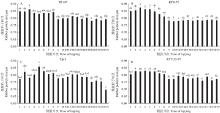
Fig.1
Effect of intensive tapping and ethrel stimulation on the rubber particle size of latex A–D: Rubber particle diameter of latex from PR107, RY8-79, Tjir1and RY7-33-97, respectively. 1?10 show the latex samples under intensive tapping; ET1–ET9 show the latex samples under intensive tapping combined with ethrel stimulation. The value of column is the average size of rubber particle for 3 reduplicative samples, different lowercase letters indicate significant difference in the level of 0. 05 (P<0.05)."

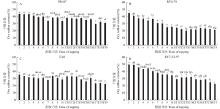
Fig.2
Effect of intensive tapping and ethrel stimulation on the dry rubber content of latex A–D: Dry rubber content of PR107, RY8-79, Tjir1 and RY7-33-97, respectively. 1–10 show the latex samples under eintensive tapping; ET1–ET9 show the latex samples under intensive tapping combined with ethrel stimulation. The dry rubber content is average value of 3 reduplicative samples, different lowercase letters indicate significant difference in the level of 0. 05(P<0.05)."

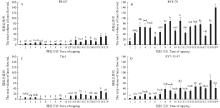
Fig.3
Effect of intensive tapping and ethrel stimulation on the total volume of latex A–D: Latex volume of PR107, RY8-79, Tjir1 and RY7-33-97, respectively. 1–10 show the latex samples under intensive tapping; ET1–ET9 show the latex samples under excessive tapping combined with ethrel stimulation. The total volume of latex is average value of 3 reduplicative samples, different lowercase letters indicate significant difference in the level of 0. 05(P<0.05)."

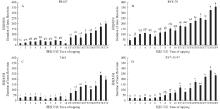
Fig.4
Effect of intensive tapping and ethrel stimulation on the duration of latex flow A–D: Duration of latex flow of PR107, RY8-79, Tjir1 and RY7-33-97, respectively. 1–10 show the latex samples under intensive tapping; ET1–ET9 show the latex samples under intensive tapping combined with ethrel stimulation. The duration of latex flow is average value of 3 reduplicative samples, different lowercase letters indicate significant difference in the level of 0. 05(P<0.05)."


Fig.5
Effect of intensive tapping and ethrel stimulation on the initial velocity of latex flow A–D: Initial velocity of latex flow of PR107, RY8-79, Tjir1 and RY7-33-97, respectively. 1–10 show the intensive tapping; ET1–ET9 show the intensive tapping combined with ethrel stimulation.The initial velocity of latex flow is average value of 3 reduplicative samples, different lowercase letters indicate significant difference in the level of 0. 05(P<0.05)."

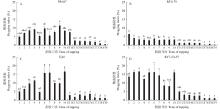
Fig.6
Effect of intensive tapping and ethrel stimulation on the plugging index A–D: Plugging index of latex flow of PR107, RY8-79, Tjir1 and RY7-33-97, respectively. 1–10 show the intensive tapping; ET1–ET9 show the intensive tapping combined with ethrel stimulation. The plugging index is average value of 3 reduplicative samples, different lowercase letters indicate significant difference in the level of 0. 05(P<0.05)."

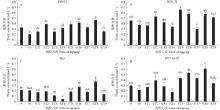
Fig.7
Effect of intensive tapping and ethrel on the thiols content of latex A–D: Thiols content of latex flow of PR107, RY8-79, Tjir1 and RY7-33-97, respectively. 1–10 show the excessive tapping; ET1–ET9 show the excessive tapping combined with ethrel stimulation. The thiols content is average value of 3 reduplicative samples, different lowercase letters indicate significant difference in the level of 0. 05(P<0.05)."

|
郭冰冰, 代龙军, 杨 洪, 等. 橡胶树排胶机理与调控研究进展. 热带作物学报, 2022, 43 (4): 754- 768.
doi: 10.3969/j.issn.1000-2561.2022.04.012 |
|
|
Guo B B, Dai L J, Yang H, et al. Research progress on mechanism and regulation of latex flow in Hevea brasiliensis Muell. Arg. Chinese Journal of Tropical Crops, 2022, 43 (4): 754- 768.
doi: 10.3969/j.issn.1000-2561.2022.04.012 |
|
| 胡彦师, 程 汉, 曾 霞, 等. 13份橡胶树新种质对已烯利刺激割制的生理反应. 中国农学通报, 2009, 25 (17): 282- 288. | |
| Hu Y S, Cheng H, Zeng X, et al. Physiological response of thirteen new Amazon Hevea germplasm to stimulation tapping system. Chinese Agricultural Science Bulletin, 2009, 25 (17): 282- 288. | |
| 黄华孙, 吴运通. 2005. 中国橡胶树育种五十年. 北京: 中国农业出版社. | |
| Huang H S, Wu Y T. 2005. Fifty years of rubber tree breeding. Beijing: China Agriculture Press.[in Chinese] | |
|
李维国, 高新生, 张伟算, 等. 橡胶树优良品种热研8-79 的选育. 热带作物学报, 2009, 30 (10): 1389- 1393.
doi: 10.3969/j.issn.1000-2561.2009.10.001 |
|
|
Li W G, Gao X S, Zhang W S, et al. Breeding and selection of desirable rubber clone Reyan 8-79. Chinese Journal of Tropical Crops, 2009, 30 (10): 1389- 1393.
doi: 10.3969/j.issn.1000-2561.2009.10.001 |
|
| 刘 辉, 胡义钰, 冯成天, 等. 乙烯利过度刺激诱发橡胶树死皮的生理效应. 林业科学, 2021, 57 (6): 46- 55. | |
| Liu H, Hu Y Y, Feng C T, et al. Physiological effects of tapping panel dryness induced by ethephon overstimulation in Hevea brasiliensis. SCIENTIA SILVAE SINICAE, 2021, 57 (6): 46- 55. | |
| 刘实忠, 校现周, 魏小弟. 2001. 不同刺激割制对橡胶树RRIM600生势的影响. 海南师范学院学报(自然科学版), 14(2): 20−22. | |
| Liu S Z, Xiao X Z, Wei X D. 2001. Effects of different tapping systems on the growth of RRIM600 rubber trees. Journal of Hainan Normal University(Natural Science), 14(2): 20−22.[in Chinese] | |
| 刘实忠, 许闻献, 蔡世英, 等. 橡胶树导胶引起生理生化变化的研究. 热带热作物学报, 2000, (1): 8- 14. | |
| Liu S Z, Xu W X, Cai S Y, et al. The physiological feature changes of Hevea trees adapting catasflow. Chinese Journal of Tropical Crops, 2000, (1): 8- 14. | |
|
罗明武, 邓柳红. 巴西橡胶树产胶与排胶机制研究进展. 林业科学, 2006, 42 (9): 127- 130.
doi: 10.3321/j.issn:1001-7488.2006.09.024 |
|
|
Luo M W, Deng L H. Advances in mechanisms of latex regeneration and latex flow of Hevea brasiliensis. Scientia Silvae Sinicae, 2006, 42 (9): 127- 130.
doi: 10.3321/j.issn:1001-7488.2006.09.024 |
|
|
罗世巧, 魏小弟, 校现周, 等. 橡胶树五天一刀低频割胶制度的研究. 热带作物学报, 2002, 23 (3): 12- 20.
doi: 10.3969/j.issn.1000-2561.2002.03.003 |
|
|
Luo S Q, Wei X D, Xiao X Z, et al. Low frequency tapping system (d/5) for rubber tree. Chinese Journal of Tropical Crops, 2002, 23 (3): 12- 20.
doi: 10.3969/j.issn.1000-2561.2002.03.003 |
|
| 罗世巧, 许闻献. 不同刺激频率对PR107生理效应的调节作用. 热带作物研究, 1990, (4): 22- 28. | |
| Luo S Q, Xu W X. The regulation effect of different stimulation frequency on physiology of PR107. Research of Tropical Crops, 1990, (4): 22- 28. | |
|
仇 键, 校现周, 高宏华, 等. 六天一刀割制对热研7-33-97幼龄开割橡胶树产量、胶乳生理及死皮病发生的影响. 南方农业学报, 2020a, 51 (1): 133- 139.
doi: 10.3969/j.issn.2095-1191.2020.01.017 |
|
|
Qiu J, Xiao X Z, Gao H H, et al. Effects of tapping per six days system on the yield, latex physiology and tapping panel dryness of young tapped Hevea brasiliensis var. Reyan 7-33-97. Journal of Southern Agriculture, 2020a, 51 (1): 133- 139.
doi: 10.3969/j.issn.2095-1191.2020.01.017 |
|
|
仇 键, 校现周, 高宏华, 等. 中龄PR107和热研7-33-97橡胶树“6天1刀”割制的刺激技术及适应性研究初报. 热带作物学报, 2020b, 41 (3): 474- 481.
doi: 10.3969/j.issn.1000-2561.2020.03.008 |
|
|
Qiu J, Xiao X Z, Gao H H, et al. Stimulation technology and adaptability of d6 tapping system for mid-aged Hevea clone PR107 and Reyan 7-33-97. Chinese Journal of Tropical Crops, 2020b, 41 (3): 474- 481.
doi: 10.3969/j.issn.1000-2561.2020.03.008 |
|
| 史敏晶, 程 成, 田维敏. 乙烯利刺激对橡胶树无性系RY8-79和PR107排胶生理参数的影响. 热带作物学报, 2015, 36 (5): 936- 932. | |
| Shi M J, Cheng C, Tian W M. Effects of ethrel on physiological parameters of latex flow in rubber tree clones RY8-79 and PR107. Chinese Journal of Tropical Crops, 2015, 36 (5): 936- 932. | |
|
史敏晶, 丁 欢, 田维敏. 巴西橡胶树排胶机制研究进展. 中国农学通报, 2022, 38 (9): 56- 65.
doi: 10.11924/j.issn.1000-6850.casb2021-0484 |
|
|
Shi M J, Ding H, Tian W M. The latex flow mechanism in rubber tree (Hevea brasiliensis Muell. Arg. ): a review. Chinese Agricultural Science Bulletin, 2022, 38 (9): 56- 65.
doi: 10.11924/j.issn.1000-6850.casb2021-0484 |
|
| 田维敏, 史敏晶, 谭海燕, 等. 2015. 橡胶树树皮结构与发育. 北京: 科学出版社. | |
| Tian W M, Shi M J, Tan H Y, et al. 2015. Bark structure and development of Hevea brasiliensis. Beijing: Science Press.[in Chinese] | |
|
王冬冬, 史敏晶, 杨署光, 等. 乙烯利对橡胶树乳管伤口堵塞相关蛋白基因表达和含量的影响. 热带作物学报, 2016, 37 (6): 1122- 1127.
doi: 10.3969/j.issn.1000-2561.2016.06.012 |
|
|
Wang D D, Shi M J, Yang S G, et al. Effect of ethrel on the gene expression and content of laticifer plugging-related protein in Hevea brasiliensis. Chinese Journal of Tropical Crops, 2016, 37 (6): 1122- 1127.
doi: 10.3969/j.issn.1000-2561.2016.06.012 |
|
|
魏 芳, 罗世巧, 高宏华, 等. 橡胶树‘热研7-20-59’气刺短线采胶技术试验初报. 中国热带农业, 2022, 104 (1): 39- 43.
doi: 10.3969/j.issn.1673-0658.2022.01.007 |
|
|
Wei F, Luo S Q, Gao H H, et al. Preliminary report on rubber tree 'Catas 7-20-59' applied on the technique of short-cut tapping with gas stimulation. China Tropical Agriculture, 2022, 104 (1): 39- 43.
doi: 10.3969/j.issn.1673-0658.2022.01.007 |
|
| 魏 芳, 李晓娟, 罗世巧, 等. 2021. 单孔采胶技术中排胶孔距离对橡胶树胶乳生理影响初报. 中国热带农业, 103: 11−17. | |
| Wei F, Li X J, Luo S Q, et al. 2021. Preliminary report on the latex physiology influence of the tapping hole distance by single-hole latex harvest technique in rubber tree. China Tropical Agriculture, 103: 11−17.[in Chinese] | |
| 魏 芳, 吴 明, 罗世巧, 等. 2014. 乙烯利刺激对橡胶树热研7-33-97 幼龄开割树的乳胶生理影响. 西部林业科学, 43(3): 93−98. | |
| Wei F, Wu M, Luo S Q, et al. 2014. Analysis of physiological characteristics effected by ethrel stimulation on clone Reyan 7-33-97 of young tapped rubber tree. Journal of West China Forestry Science, 43(3): 93−98.[in Chinese] | |
|
肖再云, 刘实忠, 校现周. 橡胶树PR107 气刺微割排胶影响面胶乳生理分析. 林业科学, 2010, 46 (9): 65- 72.
doi: 10.11707/j.1001-7488.20100911 |
|
|
Xiao Z Y, Liu S Z, Xiao X Z. Analysis on physiological parameters of latex in flow area on rubber tree (Hevea brasiliensis) clone PR107 by minicut with gaseous stimulation. Scientia Silvae Sinicae, 2010, 46 (9): 65- 72.
doi: 10.11707/j.1001-7488.20100911 |
|
| 校现周. 橡胶胶乳中 R-SH 的生理作用. 热带作物研究, 1996, (3): 5- 9. | |
| Xiao X Z. The physiological effect of R-SH on the latex in rubber tree. Chinese Journal of Tropical Crops, 1996, (3): 5- 9. | |
| 许闻献, 曾 庆, 黄文成. 中国橡胶树割制改革30 年. 热带农业科学, 2000, 20 (6): 57- 71. | |
| Xu W, Zeng Q, Huang W C. 30 years of tapping system reform for rubber tee in China. Chinese Journal of Tropical Agriculture, 2000, 20 (6): 57- 71. | |
| 许闻献, 黄圣明, 魏小弟, 等. 1981. 针刺采胶技术及其生理学研究Ⅲ. 针刺采胶排胶影响面及其叠加效应. 热带作物学报, 2(2): 13-23. | |
| Xu W X, Huang S M, Wei X D, et al. 1981. Studies on puncture tapping technique and its effects on physiology of rubber tree Ⅲ. Latex flow area of puncture tapping and its overlapping effects. Chinese Journal of Tropical Crops, 2(2): 13–23.[in Chinese] | |
| 许闻献, 潘衍庆, 魏小弟, 等. 无性系PR107 的产胶潜力及其生理特性. 热带作物学报, 1990, 11 (1): 11- 22. | |
| Xu W X, Pan Y Q, Wei X D, et al. Yield potentials and physiological characteristics of clone PR107. Chinese Journal of Tropical Crops, 1990, 11 (1): 11- 22. | |
| 杨少琼, 何宝玲. 橡胶树乳管系统功能的胶乳诊断Ⅰ. 硫醇含量的测定. 热带作物研究, 1989, (1): 65- 68. | |
| Yang S Q, He B L. Latex diagnosis of laticiferious system function in Hevea brasiliensis. Ⅰ. Determination of thiol content. Research of Tropical Crops, 1989, (1): 65- 68. | |
|
杨文凤, 刘汉文, 吴 明, 等. 不同浓度乙烯利刺激割胶对大丰95产量及生理参数的影响. 南方农业学报, 2017, 48 (11): 2052- 2057.
doi: 10.3969/j.issn.2095-1191.2017.11.21 |
|
|
Yang W F, Liu H W, Wu M, et al. Effects of ethrel stimulation with different concentrations on yield and physiological parameters of rubber tree Dafeng 95. Journal of Southern Agriculture, 2017, 48 (11): 2052- 2057.
doi: 10.3969/j.issn.2095-1191.2017.11.21 |
|
| 杨文凤, 罗世巧, 吴 明, 等. 七天一刀刺激割胶对PR107产量及生理参数的影响. 热带农业科学, 2020, 40 (3): 6- 12. | |
| Yang W F, Luo S Q, Wu M, et al. Effects of D7 stimulated tapping system on yield and physiological parameters of rubber tree clone PR107. Chinese Journal of Tropical Agriculture, 2020, 40 (3): 6- 12. | |
| 张晓飞, 黄 肖, 李 琛, 等. 6 个国外引进橡胶树品种产排胶特性研究. 广东农业科学, 2021, 48 (4): 23- 28. | |
| Zhang X F, Huang X, Li C, et al. Study on the latex physiological characteristics of six introduced Hevea brasiliensis varieties. Guangdong Agricultural Sciences, 2021, 48 (4): 23- 28. | |
|
An F, Cahill D, Rookes J, et al. Real-time measurement of phloem turgor pressure in Hevea brasiliensis with a modified cell pressure probe. Botanical Studies, 2014, 55, 19.
doi: 10.1186/1999-3110-55-19 |
|
| Bobilioff W J. 1923. Anatomy and physiology of Hevea brasiliensis. Zürich: Art Institut Orell Fussli. | |
| Boyne A F, Ellman G L. 1972. A methodology for analysis of tissue sulfhydryl components. Annals of Biochemistry, 46: 639–653. | |
|
Buttery B R, Boatman S G. Turgor pressures in phloem: measurements on Hevea latex. Science, 1964, 145 (3629): 285- 286.
doi: 10.1126/science.145.3629.285 |
|
|
Chao J Q, Chen Y Y, Wu S H, et al. Comparative transcriptome analysis of latex from rubber tree clone CATAS8-79 and PR107 reveals new cues for the regulation of latex regeneration and duration of latex flow. BMC Plant Biology, 2015, 15, 104.
doi: 10.1186/s12870-015-0488-3 |
|
| Chong F C. The role of carbohydrates in the exploitation and latex flow of Hevea. Journal of Rubber Research Inst Malaysia, 1981, 29 (2): 125- 126. | |
| Coupé M, Chrestin H. 1989. Physico-chemical and biochemical mechanisms of hormonal (ethylene) stimulation// d’Auzac J, Chrestin J H, eds. Physiology of rubber tree latex. Boca Raton, FL: CRC Press, 295–319. | |
| d’Auzac J, Jacob J L , Chrestin H. 1989. Physiology of Rubber Tree Latex. Boca Raton, Florida: CRC Press | |
|
Dai L J, Yang H, Zhao X Z, et al. Identification of cis conformation natural rubber and proteins in Ficus altissima Blume latex. Plant Physiology and Biochemistry, 2021, 167, 376- 384.
doi: 10.1016/j.plaphy.2021.08.015 |
|
| Frey-Wyssling A. 1932. Investigations on the dilution reaction and the movement of the latex of Hevea brasiliensis during tapping. Arch Rubbercult, 16: 285-327. | |
| Gomez J B. 1982. Anatomy of Hevea and its influence on latex production. Kuala Lumpur: Malaysian Rubber Research and Development Board. | |
| Kush A. 1994. Isoprenoid biosynthesis: the Hevea factory! Plant Physiology and Biochemistry, 32: 761–767. | |
|
Nakano Y, Mitsuda N, Ide K, et al. Transcriptome analysis of Pará rubber tree (H. brasiliensis) seedlings under ethylene stimulation. BMC Plant Biology, 2021, 21, 420.
doi: 10.1186/s12870-021-03196-y |
|
| Schmidt T, Lenders M, Hillebrand A, et al. 2010. Characterization of rubber particles and rubber chain elongation in Taraxacum koksaghyz. BMC Biochemistry, 11: 11. | |
|
Shi M J, Cai F G, Tian W M. Ethrel-stimulated prolongation of latex flow in the rubber tree (Hevea brasiliensis Muell. Arg. ): an Hev b 7-like protein acts as a universal antagonist of rubber particle aggregating factors from lutoids and C-serum. Journal of Biochemistry, 2016, 159 (2): 209- 16.
doi: 10.1093/jb/mvv095.Epub2015Sep17 |
|
|
Shi M, Li Y, Deng S, et al. The formation and accumulation of protein-networks by physical interactions in the rapid occlusion of laticifer cells in rubber tree undergoing successive mechanical wounding. BMC Plant Biology, 2019, 19, 8.
doi: 10.1186/s12870-018-1617-6 |
|
| Southorn W, Yip E. Latex flow studies. Ⅲ. Electrostatic consideration in the colloidal stability of fresh Hevea latex. Journal of Rubber Research, 1968, 20, 201. | |
|
Tungngoen K, Kongsawadworakul P, Viboonjun U, et al. Involvement of HbPIP2; 1 and HbTIP1; 1 aquaporins in ethylene stimulation of latex yield, through regulation of water exchanges between inner liber and latex cells in Hevea brasiliensis. Plant Physiology, 2009, 151 (2): 843- 856.
doi: 10.1104/pp.109.140228 |
|
|
Tupy J. The regulation of invertase activity in the latex of Hevea brasiliensis. Journal of Experimental Botany, 1973, 24, 516- 524.
doi: 10.1093/jxb/24.3.516 |
|
|
Wang X, Shi M, Wang D, et al. Comparative proteomics of primary and secondary lutoids reveals that chitinase and glucanase play a crucial combined role in rubber particle aggregation in Hevea brasiliensis. Journal of Proteome Research, 2013, 12 (11): 5146- 5159.
doi: 10.1021/pr400378c |
|
|
Wititsuwannakul R, Rukseree K, Kanokwiroon K, et al. A rubber particle protein specific for Hevea latex lectin binding involved in latex coagulation. Phytochemistry, 2008, 69 (5): 1111- 1118.
doi: 10.1016/j.phytochem.2007.12.007 |
|
|
Xin S C, Hua Y W, Li J, et al. Comparative analysis of latex transcriptomes reveals the potential mechanisms underlying rubber molecular weight variations between the Hevea brasiliensis clones RRIM600 and Reyan7-33-97. BMC Plant Biology, 2021, 21, 244.
doi: 10.1186/s12870-021-03022-5 |
|
| Zhu J H, Zhang Z L. Ethylene stimulation of latex production in Hevea brasiliensis. Plant Signaling & Behavior, 2009, 4, 1072- 1074. |
| [1] | Ping Liu,Yufeng Xie,Ting Yuan,Xian Gong,Lijun Qin. Seasonal Dynamics of Morphology, Fatty Acid Composition and Molecular Weight of Gum Particles in Eucommia ulmoides Leaves [J]. Scientia Silvae Sinicae, 2023, 59(4): 57-67. |
| [2] | Rui Bai,Ning Li,Shaojun Liu,Xiaomin Chen,Haiping Zou,Run Lü. Risk Analysis of White Root Disease on Rubber Trees in China under the Background of Future Climate Change [J]. Scientia Silvae Sinicae, 2021, 57(6): 37-45. |
| [3] | Shi Minjing, Wu Jilin, Hao Bingzhong, Tan Haiyan, Tian Weimin. Ultrastructural Evidence for the Origination of Rubber Particles in Rubber Tree(Hevea brasiliensis) [J]. Scientia Silvae Sinicae, 2016, 52(2): 114-119. |
| [4] | Wang Jin, An Feng, Cai Xiuqing, Zou Zhi, Zhang Wei, Lin Weifu. Functional Characterization and Expression Analysis of Aquaporin Genes (HbPIP 1 and HbPIP 2) in Hevea brasiliensis [J]. Scientia Silvae Sinicae, 2014, 50(1): 69-75. |
| [5] | Luo Mingwu;Deng Liuhong. Advances in Mechanisms of Latex Regeneration and Latex Flow of Hevea brasiliensis [J]. Scientia Silvae Sinicae, 2006, 42(9): 127-130. |
| [6] | Wang Minjie;Han Yuzhen;Liu Weiping;Fu Yongfu;Zhao Degang. ISOLATION, PURIFICATION AND ANTIBODY RAISING OF RUBBER PARTICLE BINDING PROTEINS FROM EUCOMMIA ULMOIDES [J]. Scientia Silvae Sinicae, 2003, 39(4): 23-29. |
| Viewed | ||||||
|
Full text |
|
|||||
|
Abstract |
|
|||||